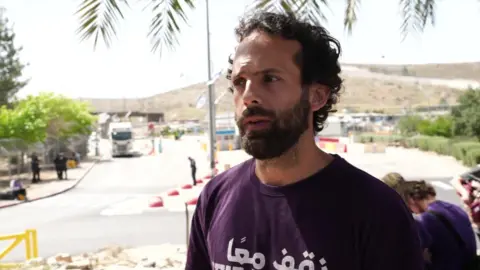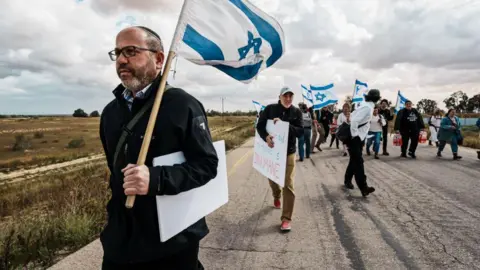Paul Adams,Diplomatic correspondent
The war in Gaza is being fought on many fronts.
One of them is aid.
Months after some Israelis started to protest against aid lorries entering Gaza at the main Kerem Shalom crossing, the battle has moved to other key junctions, where rival groups of activists do their best to block or protect aid convoys.
In recent weeks, social media has been flooded with images of aid lorries being blocked and ransacked.
Right-wing activists, including Jewish settlers living in the occupied West Bank, have uploaded dozens of videos of crowds, including some very young children, hurling food onto the ground and stamping on aid boxes.
“It’s important to stop the aid,” one activist says. “It’s the only way we’ll win. “The only way we’ll get our hosts back.”
Many argue that Gazans should receive nothing while Israeli hostages remain in captivity, and that providing aid to Gaza merely serves to prolong the war.
In one video, a group of jubilant protesters dance and celebrate on top of a looted lorry.
In another, one of the stranded lorries is ablaze.
Other videos show Israeli vigilantes stopping lorries in Jerusalem and demanding that drivers show papers proving they are not transporting aid to Gaza. Their faces are uncovered and they appear to be acting with complete impunity.
In the West Bank, at least two drivers who were not carrying goods bound for Gaza were dragged from their cabs and beaten.
Palestinian lorry drivers say they’re traumatized.
“I’m terrified to reach the crossing point,” Adel Amro told the BBC.
“I fear for my life.”
Mr Amro was carrying commercially purchased goods from the West Bank to Gaza when he was set upon. Other targeted drivers are involved in transporting aid from Jordan, which has to cross the West Bank and Israel before it reaches Gaza.
“We’re now taking side roads, far from the main routes, because we fear the aggressiveness of the settlers,” he said.
 AFP
AFPBut after a series of well-documented attacks, some Israelis are fighting back.
Peace activists have taken to tracking their opponents’ movements on social media and making sure they’re present at key crossing points.
At Tarqumiya checkpoint, where lorries enter Israel from the southern West Bank, members of the group Standing Together are now mounting regular vigils.
Tarqumiya was the scene of one of the most dramatic recent attacks.
“People in Gaza are starving and aid should get to Gaza,” said Suf Patishi, one of Standing Together’s founding members.
“Israeli society should say in a loud and clear voice that we are opposed to these acts,” he said of the recent attacks on convoys.
“It’s not a lot to ask, not to die from hunger, you know.”

The group brings together Jews and Arabs from all over Israel.
For Nasser Odat, an Israeli Arab from Haifa, coming to Tarqumiya provided a welcome opportunity to feel useful, after more than seven months of helplessly watching the war in Gaza.
“I feel very empowered,” he said. “Now, finally, I have something to do to help. “To help these people who are starving.”
As the peace activists sheltered from the fierce sun under palm trees at the center of a roundabout, passing lorry drivers waved and sounded their horns in gratitude.
A small group of right-wing demonstrators arrived but were heavily outnumbered by Mr Patishi’s volunteers.
The two sides debated their differing positions in discussions that became increasingly heated.
Police officers stood nearby, ready to keep the opposing camps apart if it came to blows.
The peace activists have accused the police, under the control of National Security Minister Itamar Ben-Gvir, one of the most hardline members of Benjamin Netanyahu’s government, of doing little to stop the attacks.
They say there’s evidence that settlers are receiving help from the authorities and point to text messages in which groups organizing attacks on aid lorries request and receive help from the police and army.
 Getty Images
Getty Images“A lot of times the police were in the areas when attacks occur, but they didn’t have someone to push them to act,” Mr Patishi said.
“And it’s very sad because the police should keep the law.”
As lorries drove by, two young women waved an Israeli flag but stopped short of trying to stop the traffic.
The two, who asked to be identified as Ariel and Shira (not their real names), explained why they felt it was important to be there.
“We would prefer that we don’t have to do the blockages, honestly,” Ariel said.
“I don’t like ransacking things. It’s not one of my favorite hobbies. But we prefer that to the death of our friends and family, which is what happens the longer this war drags on.”
Both women recognized that there might be starvation in Gaza, but were convinced that Hamas was stealing and stockpiling aid rather than distributing it to people in need.
And they were not worried about what sort of image of Israel was being projected by the scenes of aid lorries being stopped, ransacked and set on fire.
“It’s time to stop caring what everyone else thinks,” Shira said, “and do what’s necessary to protect my life, to protect my family.”
As for the police, Ariel was dismissive.
“They aren’t going to interfere if they aren’t certain they’re able to shut it down,” she said. “They’re not going to start something they can’t finish.”



